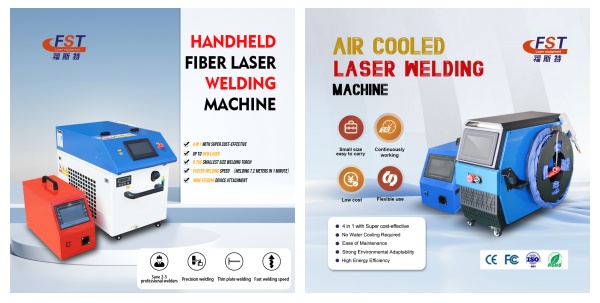When it comes to handheld laser welding machines, the market offers various options to meet the diverse needs of users. Among the most popular choices are water-cooled and air-cooled handheld laser welding machines. These machines differ not only in their cooling methods but also in aspects such as size, weight, installation, maintenance, and cooling efficiency. This article explores the key distinctions between these two types of machines, helping you make an informed decision based on your specific welding requirements.
Cooling Methods: Water vs. Air
The most fundamental difference between these two machines lies in how they manage heat.
Water-Cooled Machines: These are equipped with a water tank that circulates water to cool the welding head. Water’s high specific heat capacity makes this method highly effective for heat dissipation, allowing for continuous operation without overheating.
Air-Cooled Machines: Instead of a water tank, air-cooled models use a fan to direct airflow around the welding head. This system dissipates heat efficiently, but its cooling capacity is generally lower than that of water-cooled systems, potentially limiting continuous operation time.
Size and Portability
The cooling method has a significant impact on the machine’s size and weight.
Air-Cooled Machines: Without the need for a water tank, air-cooled machines are more compact and lightweight. This makes them highly portable and easy to maneuver, especially in scenarios where frequent movement is required. Many users find their smaller footprint advantageous for on-site applications and confined spaces.
Water-Cooled Machines: Due to the inclusion of a water tank, these machines are larger and heavier. However, most models are equipped with swivel wheels, making them easy to transport despite their bulkier design.
Installation Process
Ease of installation is another key difference.
Air-Cooled Machines: These machines offer a straightforward setup process. With no water tank to connect, they are essentially plug-and-play, ideal for users who prioritize convenience.
Water-Cooled Machines: Installation is slightly more complex due to the need to integrate the water tank into the system. Proper connection and setup are essential to ensure optimal performance, which adds an extra step during installation.
Maintenance Requirements
Maintenance plays a critical role in the long-term performance of laser welding machines.
Water-Cooled Machines: These require regular monitoring and maintenance of the water tank. Tasks include periodic cleaning, water changes, and ensuring the cooling system operates efficiently. While the maintenance is manageable, it does require more attention than air-cooled models.
Air-Cooled Machines: Maintenance is simpler and primarily involves keeping the fan and air ducts clean to maintain proper airflow. With no water-related upkeep, these machines are a hassle-free option for users seeking minimal maintenance.
Cooling Efficiency
The effectiveness of the cooling method directly impacts the machine’s performance and operational limits.
Water-Cooled Machines: Thanks to water’s excellent heat absorption properties, these machines provide superior cooling, enabling extended periods of continuous operation without overheating. This makes them a better choice for high-intensity or long-duration welding tasks.
Air-Cooled Machines: While effective, air cooling is less efficient than water cooling. Prolonged use may lead to overheating, which can temporarily reduce operational time. For users with moderate or short-term welding needs, this limitation is often negligible.
Conclusion
The choice between a water-cooled and air-cooled handheld laser welding machine depends on your specific needs and priorities.
If you require compact size, lightweight portability, and simple setup, an air-cooled machine may be the ideal solution.
If you need high cooling efficiency, extended continuous operation, and can accommodate additional maintenance, a water-cooled machine is likely the better choice.
Understanding these differences allows you to select the machine that best aligns with your welding requirements, ensuring efficiency and reliability in your operations.
Post time: Jan-24-2025

